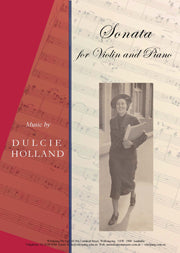Dulcie Holland
Sonata for Violin and Piano
Sonata for Violin and Piano
Couldn't load pickup availability
Share
 Violin and piano, c.15'00
Violin and piano, c.15'00
The sonata is in three movements. The first movement opens with a fanfare-type flourish played by the violin over a dominant pedal in the piano. The Edvard Grieg Sonata for Violin and Piano op. 13 in G major opens in a similar fashion and it is not known whether this sonata was a source of inspiration for Holland. The structure is not a straightforward sonata-allegro form instead it is built on several themes which reappear, closing with a coda.
The second movement is slow and in the style of a fantasy – free form. The third movement contains a jolly opening theme followed by a slower middle section. The opening theme returns to place the movement into a quasi-ternary form. It is a challenging work for both instruments and definitely an example of a duo work, both instruments playing an equal part.
Composed 1937
Researched and edited by Jeanell Carrigan
Download samplesISMN 9790720227214
$45.00 for instant PDF download of score and part 


